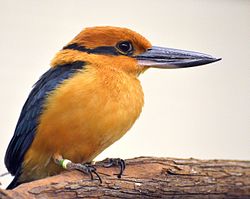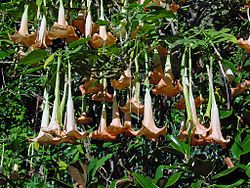Extinct in the Wild
Extinct in the Wild (EW) is a conservation status given to a species, a group of plants or animals, when the only known living members are being kept in captivity (kept in a zoo or aquarium, or planted in pots), or they are no longer living in their normal habitat.
Extinct In The Wild Media
The Hawaiian crow has been listed as extinct in the wild since 2004.
The Guam kingfisher has been extinct in the wild since 1986.
Przewalski's horse has been reintroduced, its status going from extinct in the wild to endangered.
A northern white rhino, an EW species, at the San Diego Zoo Safari Park
Brugmansia versicolor, Since March 2014, they have been listed as Extinct in the Wild by the IUCN.
| Conservation status |
|---|
| Risk of extinction |
| Extinction |
| Threatened |
| Lower risk |
| See also |
Species examples.
Examples of such animals include:
- Abingdon Island Tortoise
- Red-tailed Black Shark
- Père David's Deer
- Barbary Lion (extinct in the wild since 1922)
- Wyoming Toad (extinct in the wild since 1991)
- Hawaiian Crow (extinct in the wild since 2002)
- Alagoas Curassow (extinct in the wild since 1987 or 1988)
- Socorro Dove (extinct in the wild since 1972)
- Guam Rail (extinct in the wild since 1980)
- Black Soft-shell Turtle
- Butterfly Goodeid
- Guam kingfisher
- Kihansi spray toad
- Northern White Rhinoceros
- Partula
- Scimitar Oryx
- Spix's Macaw
Reintroduction
Reintroduction is the release of species back into the wild. They come from captivity or moved from other areas where the species survives. It usually involves species that are endangered or extinct in the wild.
It is very hard to reintroduce EW species into the wild, even if their natural habitats were fixed. The main reason may be that the survival skills, which are passed from parents to offspring during parenting, are lost. In other words, the genetics of the species are saved, but the natural skills of the species are lost.







